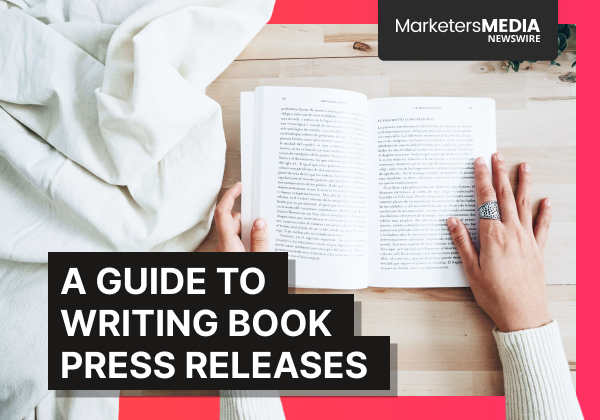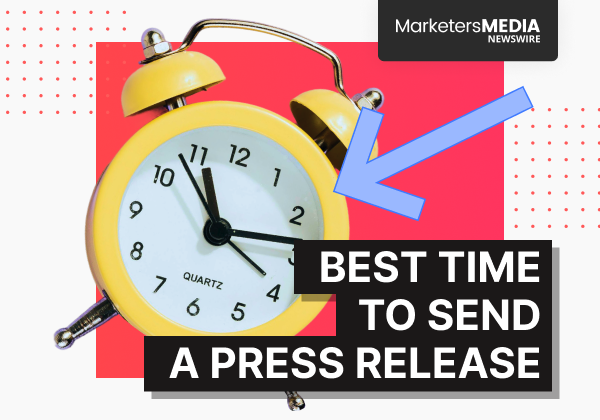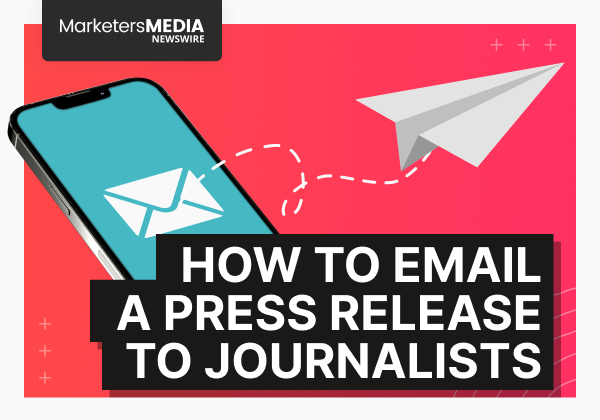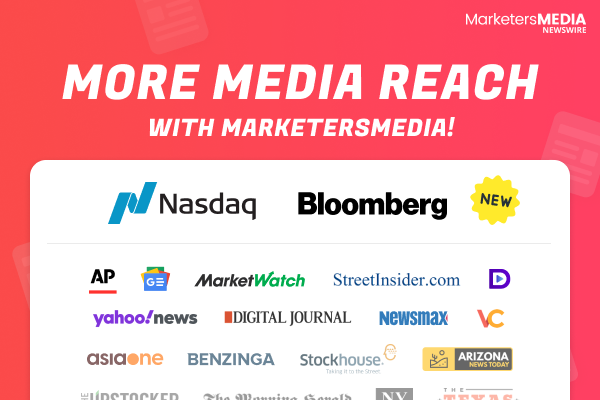You’ve written the book. Hit publish. And now… nothing but crickets.
After pouring in the hours, energy and maybe more caffeine than you’d like to admit, a new challenge begins: getting people to actually notice your book.
Sure, you could spam socials and beg friends to share your Amazon link… but wouldn’t it be nicer if the media did it for you?
Enter the book press release. It’s one of the most effective ways to get your work in front of the media, book reviewers, and potential readers.
Let’s walk through how to write one that works.
What is a Book Press Release?
A book press release is basically your book's resume. It's a one-page document that tells journalists, bloggers, and media outlets why your book matters right now.
Here's what makes it different from your typical "Hey, buy my book!" post:
- It follows an industry-standard format. Editors can instantly spot the difference between a professional release and amateur fluff.
- It tells a compelling story. Not just "I published a book," but "Ex-FBI agent exposes corruption in gripping new thriller."
- It opens doors to media coverage. When a newspaper features your book, that's not advertising – that's credibility you can't buy.
Why Authors Need Press Releases
Your mom bought your book. Your college roommate left a nice review. But getting strangers to care? That takes strategy.
A press releases solve three challenges:
- The credibility challenge. A mention in AP News or your local paper adds weight that a personal post often can’t.
- The reach challenge. Your social audience might be small, but media coverage can introduce your book to thousands of new readers.
- The positioning challenge. Instead of asking for attention, a press release helps you step into the role of an author with something newsworthy to say.
Free Book Publication Press Release Template
We’ve put together a press release template with the tailored structure.
Just fill in the blanks with your details and you’ll have a clean, polished press release that’s ready to distribute.
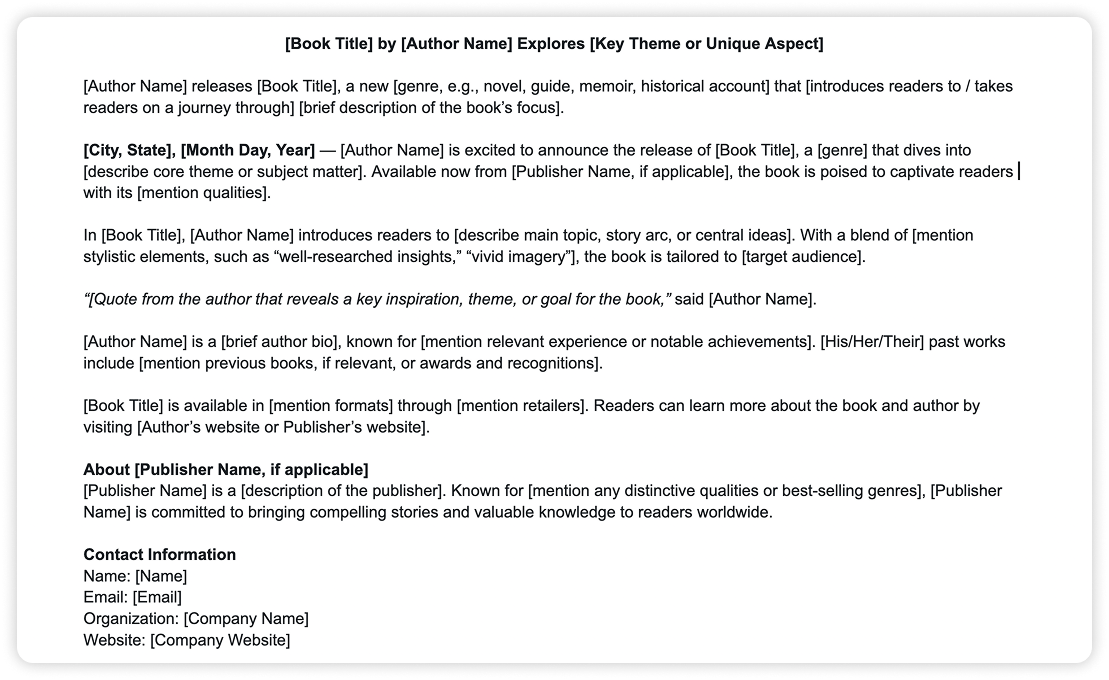
Key Elements of a Book Press Release
Headline and Subheadline
Your headline needs to grab attention in 3 seconds. Keep it short (5-8 words) and be specific:
- Less effective: “Local Author Announces New Book Launch”
- Stronger option: “Debut Thriller Explores Psychology of Revenge”
Use the subheadline to add context without cluttering the main hook.
Lead Paragraph
Your first paragraph should answer: Who wrote the book, what's it about, when it’s available, and why it matters.
Don't start with corporate speak like "XYZ Publishing today announces..." Lead with what makes the book interesting. For example, “Psychologist shares breakthrough insights on burnout in new guide to mental resilience.”
Book Synopsis
This isn't your back-cover blurb. It’s your press-friendly pitch.
- For fiction: Highlight character, conflict, and stakes (no spoilers).
- For non-fiction: Focus on the problem, solution, and takeaway.
Think movie trailer, not Wikipedia summary.
Author Bio
Include key credentials and keep it under 100 words: previous books, relevant experience, awards, or personal connection to your topic.
Focus on credibility, not your life story.
Strategic Quotes
Every good press release needs quotes. Why? Because it adds colour and makes it easier for journalists to cover your story.
Include at least one from you explaining why you wrote the book. If you've got early praise from reviewers or industry experts, add those too.
Make them quotable and engaging.
Instead of: “I wanted to write a book for years.”
Write: “I wrote this book as a lesson from five years of helping small businesses grow.”
Availability Information
Clearly state where and when the book is available, and in what formats.
Include links (ie. Amazon, Barnes & Noble, your website), release date, and whether it’s an ebook, paperback, or audiobook.
Contact Information
Journalists work fast. If they can't reach you easily, they'll move on to the next story.
Include your email, phone number, and website. Put this info at the top and bottom of your release.
Book Press Release Examples
Press Release Example #1

What makes this work:
- Tackles a hot issue: GLP-1 drugs (Ozempic, Wegovy) are everywhere in the news, and this press release taps right into that.
- Personal story: Her 70-pound weight loss and Ironman journey adds credibility to her advice.
- Clear call to action: Availability, Kindle promo, Amazon link, and coaching tie-ins are all listed.
- Social mission: Proceeds support a nonprofit for survivors of IPV — adds depth and story angle.
Press Release Example #2
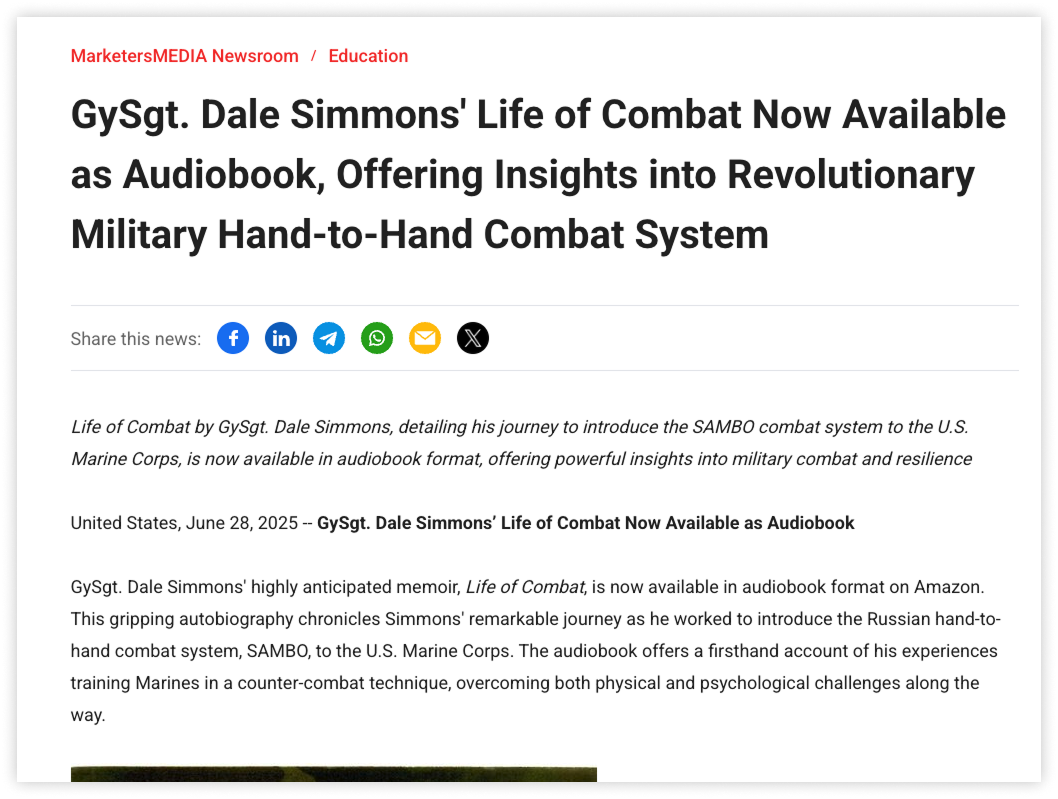
What makes this work:
- Personal storytelling: Experience from childhood trauma to military instructor, builds emotional connection and trust.
- Strong quote: “It wasn’t just about teaching combat—it was about ensuring they were prepared for the realities of close-quarters combat.”
- Audiobook mention: Nice touch for media outlets that cover audio formats or military memoirs.
- Real-world recognition: Mentioning his martial arts instructor award gives external validation.
Press Release Example #3
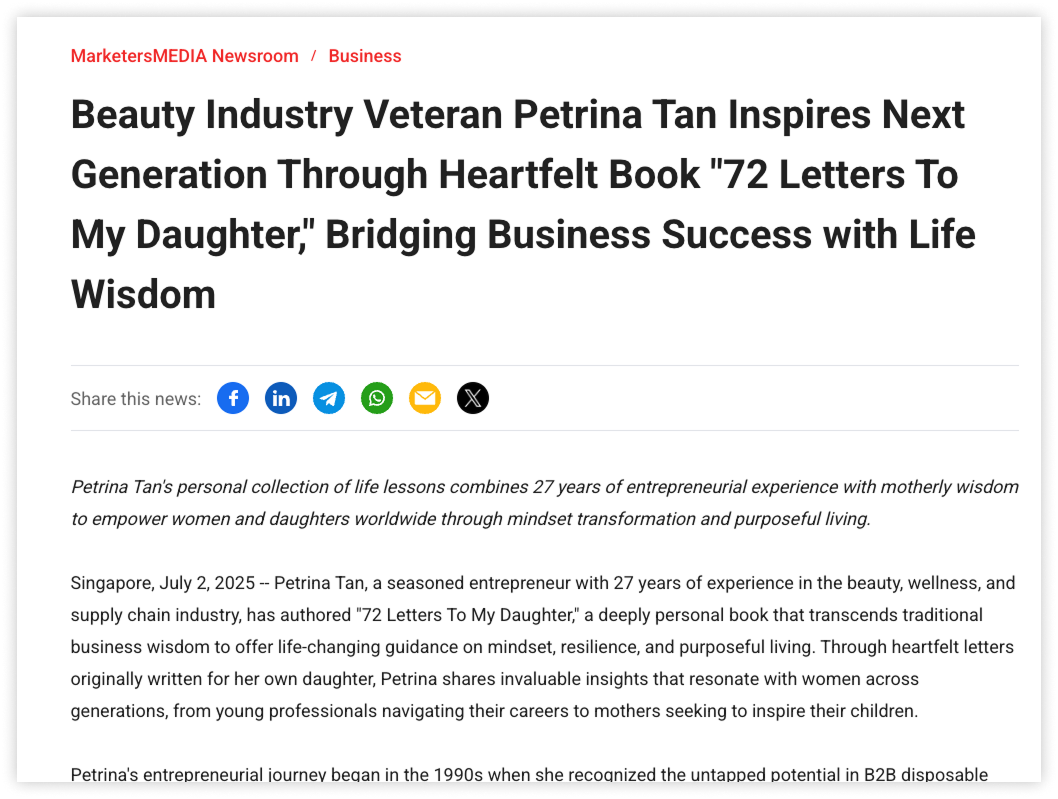
What makes this work:
- Blends business and motherhood: A personal book from a seasoned entrepreneur to her daughter makes it emotionally resonant.
- Generational hook: Perfect for stories about mentorship, growth mindset, or parenting through business lessons.
- Strong messaging: “True success extends far beyond business achievements” is both meaningful and quotable.
- Backed by experience: 27 years in business and pivoting during COVID adds authority.
Press Release Example #4
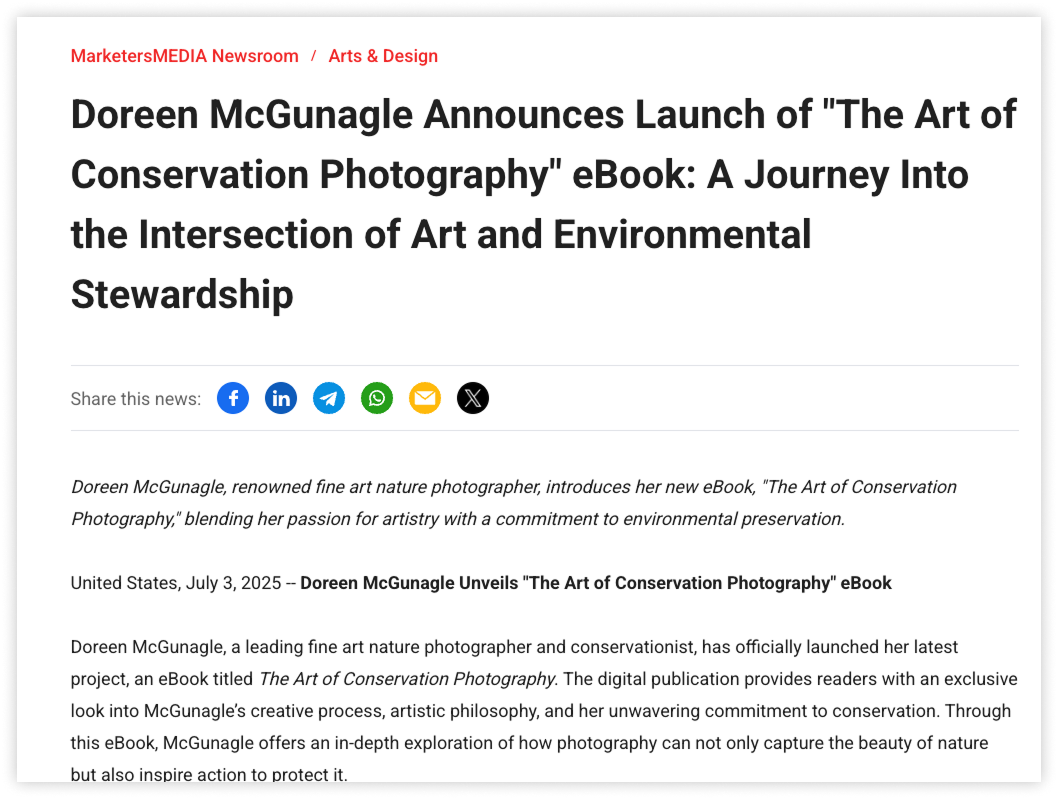
What makes this work:
- Strong niche topic: Combines art and environmental activism, ideal for eco or culture reporters.
- Emotional imagery: Instead of simply sharing the photos, she tells the story behind each one, which adds emotional pull.
- Quotes feel personal: “Photography is not just about what you see — it’s about what you feel.” That’s a strong line for an art coverage.
- Clear CTA: including her website and eBook link allows people to find her easily.
Where to Distribute Your Press Release
Your Own Channels
Start with your website and social media. This creates a central hub for information and provides SEO benefits. Your existing audience becomes your first wave of promotion.
Direct Media Outreach
Local News Media. Contact your city's newspapers, radio stations, and TV stations. Local authors are often seen as hometown success stories, making them appealing guests for interviews, features, and event coverage.
Target specific journalists. Research reporters who cover your genre or topic. Personalize your pitch to their interests and recent coverage.
For more tips on where and how to submit your press release, check out our press release submission strategy guide.
Professional Distribution Services
Professional press release distribution services can help you reach a wide media audience with proper formatting and broad syndication. While they often come at a cost, they offer exposure across news sites, search engines, and media databases. Some budget-friendly or free platforms also exist.
For broader distribution, MarketersMEDIA Newswire provides guaranteed pickup across 550+ media outlets with a potential reach of 5.9 billion, serving across 160 countries.
Review Platforms
Publishers Weekly charges $25 for review consideration (self-published authors submit through BookLife). Send your release about six months before publication.
Booksprout connects you with over 75,000 active reviewers on Amazon, BookBub, and Goodreads.
NetGalley is the industry standard for distributing digital galleys to book advocates and professionals.
Strategic Timing
Don't wait until your book is published. Start building buzz months in advance.
Timeline example:
- 18 months before: "Coming Soon" announcements
- 6 months before: ARC (Advance Reader Copy) requests to reviewers
- Launch day: Official availability announcement
- Post-launch: Milestone achievements (bestseller status, awards)
Long-lead publications like magazines need 2-3 months advance notice. Digital media can work with shorter timelines.
If you’re still unsure about when to send your press release for the best results, read this timing guide.
Common Mistakes to Avoid
Sending as a PDF file. Journalists generally dislike them because copying and pasting loses formatting. Plain text within the email body or a Word document is typically preferred.
Emailing as an attachment. Embed your release directly in the email body. Most business email users are hesitant to open attachments due to concerns about viruses and other potential security issues.
Being too salesy or hyped. The tone should be informative and engaging, not overtly salesy or filled with marketing hype. The primary objective is to gain media coverage, not to directly sell a product.
Putting your name in the headline. Unless you're already famous, the headline should focus on the important information about the book itself.
Don't forget to proofread. Typos, spelling errors, capitalization inconsistencies, and misused punctuation reflect poorly on the author's brand and can cause reviewers to cease reading.
Making Your Press Release Work
Journalists evaluate press releases on an effort-to-reward ratio. Make their job easy by following standard formats, being concise, and providing clear value.
A well-crafted press release can transform your book from another self-published title into a legitimate news story. It's the difference between shouting into the void and having respected voices amplify your message.
Start with your news angle, follow the format, time it strategically, and distribute it widely. Your book deserves professional treatment and a professional press release is where that begins.
Free Press Release Template
Tell us where to send your PDF:
